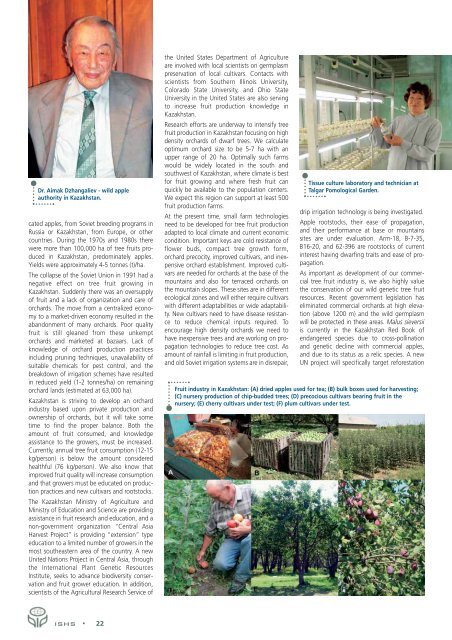The World Foliage Plant Industry - Acta Horticulturae
The World Foliage Plant Industry - Acta Horticulturae
The World Foliage Plant Industry - Acta Horticulturae
Create successful ePaper yourself
Turn your PDF publications into a flip-book with our unique Google optimized e-Paper software.
Dr. Aimak Dzhangaliev - wild apple<br />
authority in Kazakhstan.<br />
cated apples, from Soviet breeding programs in<br />
Russia or Kazakhstan, from Europe, or other<br />
countries. During the 1970s and 1980s there<br />
were more than 100,000 ha of tree fruits produced<br />
in Kazakhstan, predominately apples.<br />
Yields were approximately 4-5 tonnes (t)/ha.<br />
<strong>The</strong> collapse of the Soviet Union in 1991 had a<br />
negative effect on tree fruit growing in<br />
Kazakhstan. Suddenly there was an oversupply<br />
of fruit and a lack of organization and care of<br />
orchards. <strong>The</strong> move from a centralized economy<br />
to a market-driven economy resulted in the<br />
abandonment of many orchards. Poor quality<br />
fruit is still gleaned from these unkempt<br />
orchards and marketed at bazaars. Lack of<br />
knowledge of orchard production practices<br />
including pruning techniques, unavailability of<br />
suitable chemicals for pest control, and the<br />
breakdown of irrigation schemes have resulted<br />
in reduced yield (1-2 tonnes/ha) on remaining<br />
orchard lands (estimated at 63,000 ha).<br />
Kazakhstan is striving to develop an orchard<br />
industry based upon private production and<br />
ownership of orchards, but it will take some<br />
time to find the proper balance. Both the<br />
amount of fruit consumed, and knowledge<br />
assistance to the growers, must be increased.<br />
Currently, annual tree fruit consumption (12-15<br />
kg/person) is below the amount considered<br />
healthful (76 kg/person). We also know that<br />
improved fruit quality will increase consumption<br />
and that growers must be educated on production<br />
practices and new cultivars and rootstocks.<br />
<strong>The</strong> Kazakhstan Ministry of Agriculture and<br />
Ministry of Education and Science are providing<br />
assistance in fruit research and education, and a<br />
non-government organization “Central Asia<br />
Harvest Project” is providing “extension” type<br />
education to a limited number of growers in the<br />
most southeastern area of the country. A new<br />
United Nations Project in Central Asia, through<br />
the International <strong>Plant</strong> Genetic Resources<br />
Institute, seeks to advance biodiversity conservation<br />
and fruit grower education. In addition,<br />
scientists of the Agricultural Research Service of<br />
the United States Department of Agriculture<br />
are involved with local scientists on germplasm<br />
preservation of local cultivars. Contacts with<br />
scientists from Southern Illinois University,<br />
Colorado State University, and Ohio State<br />
University in the United States are also serving<br />
to increase fruit production knowledge in<br />
Kazakhstan.<br />
Research efforts are underway to intensify tree<br />
fruit production in Kazakhstan focusing on high<br />
density orchards of dwarf trees. We calculate<br />
optimum orchard size to be 5-7 ha with an<br />
upper range of 20 ha. Optimally such farms<br />
would be widely located in the south and<br />
southwest of Kazakhstan, where climate is best<br />
for fruit growing and where fresh fruit can<br />
quickly be available to the population centers.<br />
We expect this region can support at least 500<br />
fruit production farms.<br />
At the present time, small farm technologies<br />
need to be developed for tree fruit production<br />
adapted to local climate and current economic<br />
condition. Important keys are cold resistance of<br />
flower buds, compact tree growth form,<br />
orchard precocity, improved cultivars, and inexpensive<br />
orchard establishment. Improved cultivars<br />
are needed for orchards at the base of the<br />
mountains and also for terraced orchards on<br />
the mountain slopes. <strong>The</strong>se sites are in different<br />
ecological zones and will either require cultivars<br />
with different adaptabilities or wide adaptability.<br />
New cultivars need to have disease resistance<br />
to reduce chemical inputs required. To<br />
encourage high density orchards we need to<br />
have inexpensive trees and are working on propagation<br />
technologies to reduce tree cost. As<br />
amount of rainfall is limiting in fruit production,<br />
and old Soviet irrigation systems are in disrepair,<br />
Tissue culture laboratory and technician at<br />
Talgar Pomological Garden.<br />
drip irrigation technology is being investigated.<br />
Apple rootstocks, their ease of propagation,<br />
and their performance at base or mountains<br />
sites are under evaluation. Arm-18, B-7-35,<br />
B16-20, and 62-396 are rootstocks of current<br />
interest having dwarfing traits and ease of propagation.<br />
As important as development of our commercial<br />
tree fruit industry is, we also highly value<br />
the conservation of our wild genetic tree fruit<br />
resources. Recent government legislation has<br />
eliminated commercial orchards at high elevation<br />
(above 1200 m) and the wild germplasm<br />
will be protected in these areas. Malus sieversii<br />
is currently in the Kazakhstan Red Book of<br />
endangered species due to cross-pollination<br />
and genetic decline with commercial apples,<br />
and due to its status as a relic species. A new<br />
UN project will specifically target reforestation<br />
Fruit industry in Kazakhstan: (A) dried apples used for tea; (B) bulk boxes used for harvesting;<br />
(C) nursery production of chip-budded trees; (D) precocious cultivars bearing fruit in the<br />
nursery; (E) cherry cultivars under test; (F) plum cultivars under test.<br />
ISHS • 22

















